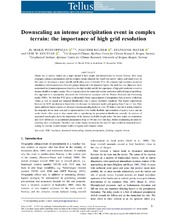| dc.contributor.author | Pontoppidan, Marie | |
| dc.contributor.author | Reuder, Joachim | |
| dc.contributor.author | Mayer, Stephanie | |
| dc.contributor.author | Kolstad, Erik Wilhelm | |
| dc.date.accessioned | 2019-06-20T12:18:35Z | |
| dc.date.available | 2019-06-20T12:18:35Z | |
| dc.date.issued | 2017 | |
| dc.Published | Pontoppidan M, Reuder J, Mayer S, Kolstad EW. Downscaling an intense precipitation event in complex terrain: the importance of high grid resolution. Tellus. Series A, Dynamic meteorology and oceanography. 2017;69(1):1271561 | eng |
| dc.identifier.issn | 1600-0870 | en_US |
| dc.identifier.issn | 0280-6495 | en_US |
| dc.identifier.uri | https://hdl.handle.net/1956/20289 | |
| dc.description.abstract | Floods due to intense rainfall are a major hazard to both people and infrastructure in western Norway. Here steep orography enhances precipitation and the complex terrain channels the runoff into narrow valleys and small rivers. In this study we investigate a major rainfall and flooding event in October 2014. We compare high-resolution numerical simulations with measurements from rain gauges deployed in the impacted region. Our study has two objectives: (i) to understand the dynamical processes that drove the high rainfall and (ii) the importance of high grid resolution to resolve intense rainfall in complex terrain. This is of great interest for numerical weather prediction and hydrological modelling. Our approach is to dynamically downscale the ERA-Interim reanalysis with the Weather Research and Forecasting model (WRF). We find that WRF gives a substantially better representation of precipitation both in terms of absolute values as well as spatial and temporal distributions than a coarse resolution reanalysis. The largest improvement between the WRF simulations is found when we decrease the horizontal model grid spacing from 9 km to 3 km. Only minor additional improvements are obtained when downscaling further to 1 km. We believe that this is mainly related to the orography in the study area and its representation in the model. Realistic representations of gravity waves and the seeder–feeder effect seem to play crucial roles in reproducing the precipitation distribution correctly. An analysis of associated wavelengths shows the importance of the shortest resolvable length scales. On these scales our simulations also show differences in accumulated precipitation of up to 300 mm over four days, further emphasising the need for resolving short wavelengths. Therefore, our results clearly demonstrate the need for high-resolution dynamical downscaling for extreme weather impact studies in regions with complex terrain. | en_US |
| dc.language.iso | eng | eng |
| dc.publisher | Taylor & Francis | en_US |
| dc.rights | Attribution CC BY | eng |
| dc.rights.uri | http://creativecommons.org/licenses/by/4.0 | eng |
| dc.subject | WRF | eng |
| dc.subject | resolution | eng |
| dc.subject | dynamical downscaling | eng |
| dc.subject | Extreme precipitation | eng |
| dc.subject | flooding | eng |
| dc.subject | complex terrain | eng |
| dc.title | Downscaling an intense precipitation event in complex terrain: the importance of high grid resolution | en_US |
| dc.type | Peer reviewed | |
| dc.type | Journal article | |
| dc.date.updated | 2019-04-24T07:59:33Z | |
| dc.description.version | publishedVersion | en_US |
| dc.rights.holder | Copyright 2017 The Author(s) | en_US |
| dc.identifier.doi | https://doi.org/10.1080/16000870.2016.1271561 | |
| dc.identifier.cristin | 1437674 | |
| dc.source.journal | Tellus. Series A, Dynamic meteorology and oceanography | |
| dc.relation.project | Notur/NorStore: NN9001K | |
| dc.relation.project | Notur/NorStore: NN9280K | |
| dc.relation.project | Regionale forskningsfond Vestlandet: 245403 | |
| dc.relation.project | Norges forskningsråd: 255397 | |

